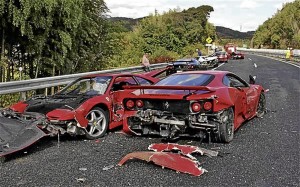Of ‘killer’ performance cars and irresponsible drivers

A botched lane change in Japan led to this pricey pileup of eight Ferraris, a Lamborghini and three Mercs.
Yes, there are cars out there that were built, it seemed, to kill their drivers. No, we’re not talking about poorly built cars here. In fact, the cars involved are top-of-the-line performance rides, the best in their class as well as the envy of those who just can’t afford them.
The idea here is that there are some performance cars that are most unforgiving if driven by those who don’t have the right skills (or believe they have).
Consider the Nissan GT-R powered by a really scary 545-horsepower, 3.8-liter twin-turbocharged V6 engine. If you’re not TOO careful about the throttle, the way you steer or apply the brakes, you might soon find yourself wrapped around a tree if not careening off the side of a mountain.
The same goes when driving the Ford Mustang V8 GT powered by a 414-horsepower, 5-liter V8 engine or the Chevrolet Camaro 2SS powered by a 400-horsepower, 6.2-liter V8 engine.
Both cars deliver a boomy bark and gobs of torque that incite you sprint beyond 200kph or even attack tight corners with astonishing ferocity.
Problem is, a sudden loss of concentration—a single nervous twitch—could get you coloring the pavement red with your fluids for several hundred meters.
With great powers…
As what French philosopher Voltaire once wrote—“with great power comes great responsibility”—you as driver of a powerful and ultra expensive car should behave responsibly on public roads.
Always remember that it’s important to respect the speed limit and never do anything that would endanger pedestrians or other motorists.
The recent accident involving a Ford GT Mustang at the Skyway that killed a police officer is a grim reminder of this.
Go easy on the gas pedal. Apply the throttle smoothly and take into consideration that your vehicle could rocket from a standstill to 100 kph in less than a few seconds.
Remember that high-performance cars, no matter how advanced their engineering may be are still governed by the laws of physics: The faster you go, the longer it takes to stop and if there is a crash, the injuries and damages to properties will be more severe.
An increase in speed also increases the driver’s so called “thinking distance.” This means the faster you go, the longer it takes to react to an unexpected situation, whether it’s a pedestrian darting across the street or another vehicle making an unexpected lane change.
According to the United Kingdom’s Royal Society for the Prevention of Road Accidents (Rospa), excessive speed contributes to 24 percent of collisions in which someone is killed, 15 percent of crashes resulting in serious injury and 14 percent of all injury collisions.
Rospa concludes that speed limits are set to help drivers understand the dangers of each road, and inform drivers of the legal maximum speed, above which the risks to the driver and other road users are too great to accept.
Remember, a lot of serious accidents begin with a frustrated, impatient driver. Don’t be a show-off and try to be patient, because traffic could suddenly turn bad and there will always be delays.
